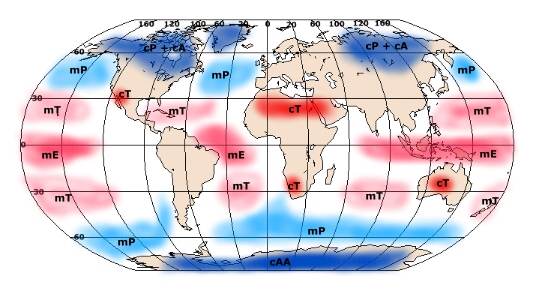Air mass typesFigure 8.1 shows the location of the air mass source regions that affect Earth's climate. Continental arctic air (cA) is typically described as extremely cold and dry. Record setting temperatures in the middle and high latitudes are due to the invasion of this very cold mass of air. At about the same latitude in the Southern Hemisphere is found the continental Antarctic (cAA) air mass. This too is an exceedingly cold air mass and is drier than its arctic counterpart as the source region is the continent of Antarctica. Continental polar (cP) air is considered a cold and dry air mass that is warmer than the arctic air mass located to the north. Continental polar air is typically a stable or conditionally stable mass of air. Maritime polar (mP) air is cool and moist air that brings mild weather to coastal locations. Maritime polar air is warmer than continental polar air in the winter as the surface temperature of the ocean is higher. Similarly, mP air masses are typically cooler than cP air masses during the summer as the continents warm more than the ocean at these latitudes. Maritime polar air masses that enter the west coast are forced to rise up coastal mountain chains causing significant orographic uplift and precipitation. In Europe, mP air masses penetrate further inland due to the east – west orientation of the mountains. Thus smaller temperature ranges and higher humidity typical of maritime climate are found further inland in Europe than in the North America.
Maritime tropical (mT) air masses are warm and moist air masses that are responsible for much of the precipitation east of the Rocky mountains in the United States. Precipitation occurs when mT air collides with cP air causing the warmer and less dense mT air to rise, cool, and condense into clouds. In the southeast portion of the United States convective uplift of air also occurs to create precipitation. Over subtropical and tropical continents the source region for the hot and dry continental tropical (cT) air mass is found. Major source regions are the great deserts of the Earth such as the Sahara, Arabian, and Australian. The extremely low humidity is due to the lack of available water for evaporation as well as the subsidence of the subtropical high. The southwest desert of the United States serves as a source region for cT air too, but only during the summer. Surface temperatures in the winter are too cold to create a continental tropical air mass there. Near the equator the exceedingly warm and humid maritime equatorial air masses form. Convection and convergence of this air mass in the Intertropical Convergence Zone is one for the reasons for the heavy rainfall experienced in the rain forests of this region. |

